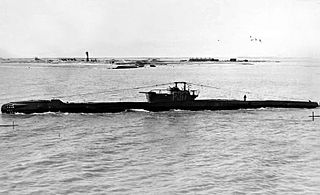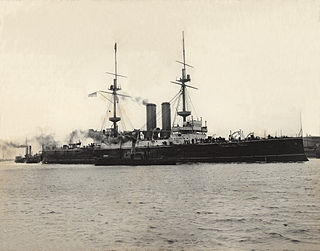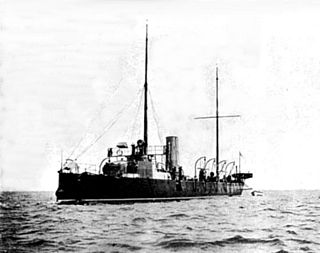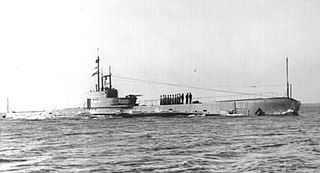
A gunboat is a naval watercraft designed for the express purpose of carrying one or more guns to bombard coastal targets, as opposed to those military craft designed for naval warfare, or for ferrying troops or supplies.

HMS Locust was one of 4 Dragonfly-class river gunboats of the Royal Navy, and was named after the locust, an insect. Launched on 28 September 1939 and commissioned on 17 May 1940, she survived the Second World War despite being severely damaged many times, including taking a shell hit during Operation Overlord.

A river gunboat is a type of gunboat adapted for river operations. River gunboats required shallow draft for river navigation. They would be armed with relatively small caliber cannons, or a mix of cannons and machine guns. If they carried more than one cannon, one might be a howitzer, for shore bombardment. They were usually not armoured. The fictional USS San Pablo described in Richard McKenna's The Sand Pebbles is an example of this class of vessel, serving on the US Navy's Yangtze Patrol. Stronger river warships with larger guns were river monitors.

HMAS Vampire was a V-class destroyer of the Royal Navy (RN) and Royal Australian Navy (RAN). Launched in 1917 as HMS Wallace, the ship was renamed and commissioned into the RN later that year. Vampire was lent to the RAN in 1933, and operated as a depot tender until just before World War II. Reactivated for war service, the destroyer served in the Mediterranean as part of the Scrap Iron Flotilla, and was escorting the British warships HMS Prince of Wales and HMS Repulse during their loss to Japanese aircraft in the South China Sea in December 1941. Vampire was sunk on 9 April 1942 by Japanese aircraft while sailing with the aircraft carrier HMS Hermes from Trincomalee.

The Insect-class gunboats were a class of small but well-armed Royal Navy ships designed for use in shallow rivers or inshore. They were intended for use on the Danube against Austria-Hungary. The first four ships—Gnat, Mantis, Moth and Tarantula—were first employed during the Mesopotamian Campaign of the First World War on the Euphrates and Tigris rivers.

HMS Rifleman was a turbine-powered Algerine-class minesweeper of the Royal Navy. She was launched in 1943 and saw active service during World War II, both in the European and Far East theatres. After the war she served in the Mediterranean and was used as an accommodation ship in Barrow before being sold for breaking in 1972.

HMS Aphis was a Royal Navy Insect-class gunboat. She was built by Ailsa Shipbuilding Company, launched on 15 September 1915 and completed in November 1915. She was based in Port Said at the beginning of World War I, served in Romania and then the China Station until 1940. All of her fighting service was in the Mediterranean, taking part in the invasion of Pantelleria and landings in the south of France, returning briefly to the Pacific in 1945. She was scrapped at Singapore in 1947. Her class was intended for shallow, fast flowing rivers and they also proved suitable for inshore operations when her relatively heavy weaponry could be used to support Army operations.

HMS Gnat was a Royal Navy Insect-class gunboat. She was built by Lobnitz and launched in 1915. Gnat saw service during the First World War as part of a flotilla operating on the Tigris and Euphrates rivers. After the war, the vessel was transferred to China, where in 1927, Gnat took part in the Nanking Incident. Gnat began the Second World War still in China, but was towed to the Mediterranean Sea in 1940. There, the gunboat took part in an assault on Tobruk before being torpedoed by a German submarine. Though Gnat did not sink, and was beached at Alexandria, Egypt where the vessel was used as an anti-aircraft platform. The vessel was declared a constructive total loss and scrapped in 1945.

The Commander-in-Chief, China, was the admiral in command of what was usually known as the China Station, at once both a British Royal Navy naval formation and its admiral in command. It was created in 1865 and deactivated in 1941.

HMS Storm was an S-class submarine of the Royal Navy, and part of the third group built of that class. She was built by Cammell Laird and launched on 18 May 1943. So far, she is the only RN ship to bear the name Storm.

HMS Tally-Ho was a British submarine of the third group of the T class. She was built as P317 by Vickers Armstrong, Barrow and launched on 23 December 1942. She has been the only ship of the Royal Navy to bear the name, that of the hunting call, "Tally-Ho!".

HMS Severn was a Humber-class monitor of the Royal Navy. Originally built by Vickers for Brazil, she was purchased by the Royal Navy in 1914 on the outbreak of the First World War along with her sister ships Humber and Mersey. She had been christened Solimoes by the Brazilians, but was renamed by the British. The three ships were the first of a new type of specialized shore-bombardment warships. As a result of her shallow draught, she was very un-manoeuvrable and unseaworthy in open waters in anything more than a Force 5 wind.

HMS Vengeance was a pre-dreadnought battleship of the British Royal Navy and a member of the Canopus class. Intended for service in Asia, Vengeance and her sister ships were smaller and faster than the preceding Majestic-class battleships, but retained the same battery of four 12-inch (305 mm) guns. She also carried thinner armour, but incorporated new Krupp steel, which was more effective than the Harvey armour used in the Majestics. Vengeance was laid down in August 1898, launched in July 1899, and commissioned into the fleet in April 1902.

HMS Rattlesnake was a unique design of torpedo gunboat of the Royal Navy. A result of the Russian war scare of 1885, she was designed by Nathaniel Barnaby that year and built by Laird Brothers, of Birkenhead. Quickly made obsolete by the new torpedo boat destroyers, she became an experimental submarine target ship in 1906, and was sold in 1910.

Flat-iron gunboats were a number of classes of coastal gunboats generally characterised by small size, low freeboard, the absence of masts, and the mounting of a single non-traversing large gun, aimed by pointing the vessel. They acquired their nickname from the physical similarity with the flat iron used for ironing clothes during the 19th century.

The Fly-class river gunboats, collectively often referred to as the "Tigris gunboat flotilla", were a class of small well-armed Royal Navy vessels designed to patrol the Tigris river during the Mesopotamian Campaign during the First World War.

HMS Rover was a Rainbow-class submarine designed and built by Vickers Shipbuilding and Engineering in Barrow-in-Furness for the Royal Navy and was launched on 11 June 1930. During its early career, Rover served in the Far East. During World War II, the submarine operated in the Mediterranean Sea, attacking several Italian convoys and providing assistance to the crippled cruiser HMS York during the evacuation of Crete in 1941, before returning to the Far East to operate against the Japanese. The vessel survived the war and was sold for scrap in 1946.

HMS Recruit was a Clydebank three-funnel, 30-knot destroyer ordered by the Royal Navy under the 1895–1896 Naval Estimates. She was the fifth ship to carry this name since it was introduced in 1806 for an 18-gun brig-sloop, sold in 1822.

HMS Caesar was one of thirty-two C-class destroyers built for the Royal Navy during the Second World War, a member of the eight-ship Ca sub-class. Commissioned in 1944, she was built as a flotilla leader with additional accommodation for staff officers. The ship was assigned to Home Fleet during 1944–1945 and escorted one Arctic convoy as well as the capital ships of the fleet.

The Battle of Amara, also known as the Second Battle of Qurna, was a military engagement between the forces of the British and Ottoman Empires during the Mesopotamian Campaign of World War I. The battle took place in the flooded marshes and islands along the Tigris river between the towns of Qurna and Amara and resulted in the British capture of Amara and rout of Ottoman forces in the area.




















